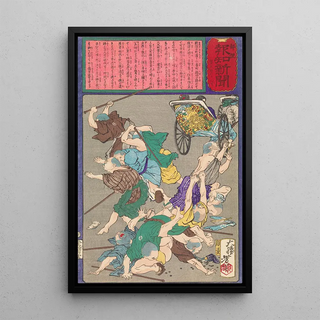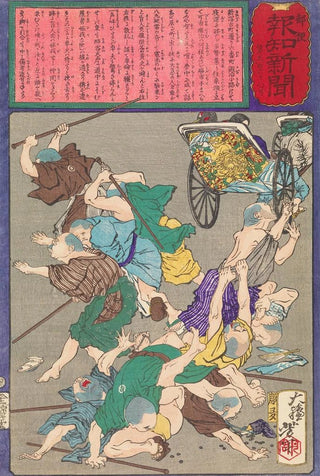Art print of a group of blind masseurs in Niigata injured by a fast rickshaw - Tsukioka Yoshitoshi


View from behind

Frame (optional)
Group of blind masseurs in Niigata injured by a fast rickshaw: a poignant art print of human fragility
In this art print of the painting "Group of blind masseurs in Niigata injured by a fast rickshaw," Tsukioka Yoshitoshi captures a scene that is both dramatic and emotional. The vivid colors and meticulous details of the characters convey an atmosphere of tension and vulnerability. The masseurs, depicted with great expressiveness, seem frozen in a moment of pain and surprise, while the rickshaw, a symbol of modernity, stands out as a disruptive element. The technique of the ukiyo-e print, characteristic of Yoshitoshi, allows playing with contrasts and emphasizing the scene's intensity.
Tsukioka Yoshitoshi: a master of Japanese ukiyo-e of the 19th century
Tsukioka Yoshitoshi, born in 1839, is one of the most influential artists of the Edo and Meiji periods in Japan. His work stands out for an innovative approach to ukiyo-e, blending tradition and modernity. Influenced by the social and political upheavals of his time, Yoshitoshi explores various themes, ranging from mythology to everyday life. His ability to capture deep human emotions and dramatic scenes has made him an iconic figure of Japanese art. This art print, "Group of blind masseurs in Niigata injured by a fast rickshaw," perfectly illustrates his talent for evoking suffering and resilience.
A decorative acquisition with multiple assets
The reproduction of "Group of blind masseurs in Niigata injured by a fast rickshaw" is an ideal choice to enhance your interior decoration. Whether in a living room, office, or bedroom, this art print draws the eye and stimulates reflection. Its print quality and fidelity to the details of the original work guarantee undeniable aesthetic appeal. By integrating this canvas into your space, you bring a touch of history and culture, while offering your guests an opportunity for dialogue around Japanese art and its profound meanings.

Matte finish

View from behind

Frame (optional)
Group of blind masseurs in Niigata injured by a fast rickshaw: a poignant art print of human fragility
In this art print of the painting "Group of blind masseurs in Niigata injured by a fast rickshaw," Tsukioka Yoshitoshi captures a scene that is both dramatic and emotional. The vivid colors and meticulous details of the characters convey an atmosphere of tension and vulnerability. The masseurs, depicted with great expressiveness, seem frozen in a moment of pain and surprise, while the rickshaw, a symbol of modernity, stands out as a disruptive element. The technique of the ukiyo-e print, characteristic of Yoshitoshi, allows playing with contrasts and emphasizing the scene's intensity.
Tsukioka Yoshitoshi: a master of Japanese ukiyo-e of the 19th century
Tsukioka Yoshitoshi, born in 1839, is one of the most influential artists of the Edo and Meiji periods in Japan. His work stands out for an innovative approach to ukiyo-e, blending tradition and modernity. Influenced by the social and political upheavals of his time, Yoshitoshi explores various themes, ranging from mythology to everyday life. His ability to capture deep human emotions and dramatic scenes has made him an iconic figure of Japanese art. This art print, "Group of blind masseurs in Niigata injured by a fast rickshaw," perfectly illustrates his talent for evoking suffering and resilience.
A decorative acquisition with multiple assets
The reproduction of "Group of blind masseurs in Niigata injured by a fast rickshaw" is an ideal choice to enhance your interior decoration. Whether in a living room, office, or bedroom, this art print draws the eye and stimulates reflection. Its print quality and fidelity to the details of the original work guarantee undeniable aesthetic appeal. By integrating this canvas into your space, you bring a touch of history and culture, while offering your guests an opportunity for dialogue around Japanese art and its profound meanings.
12,34 €






